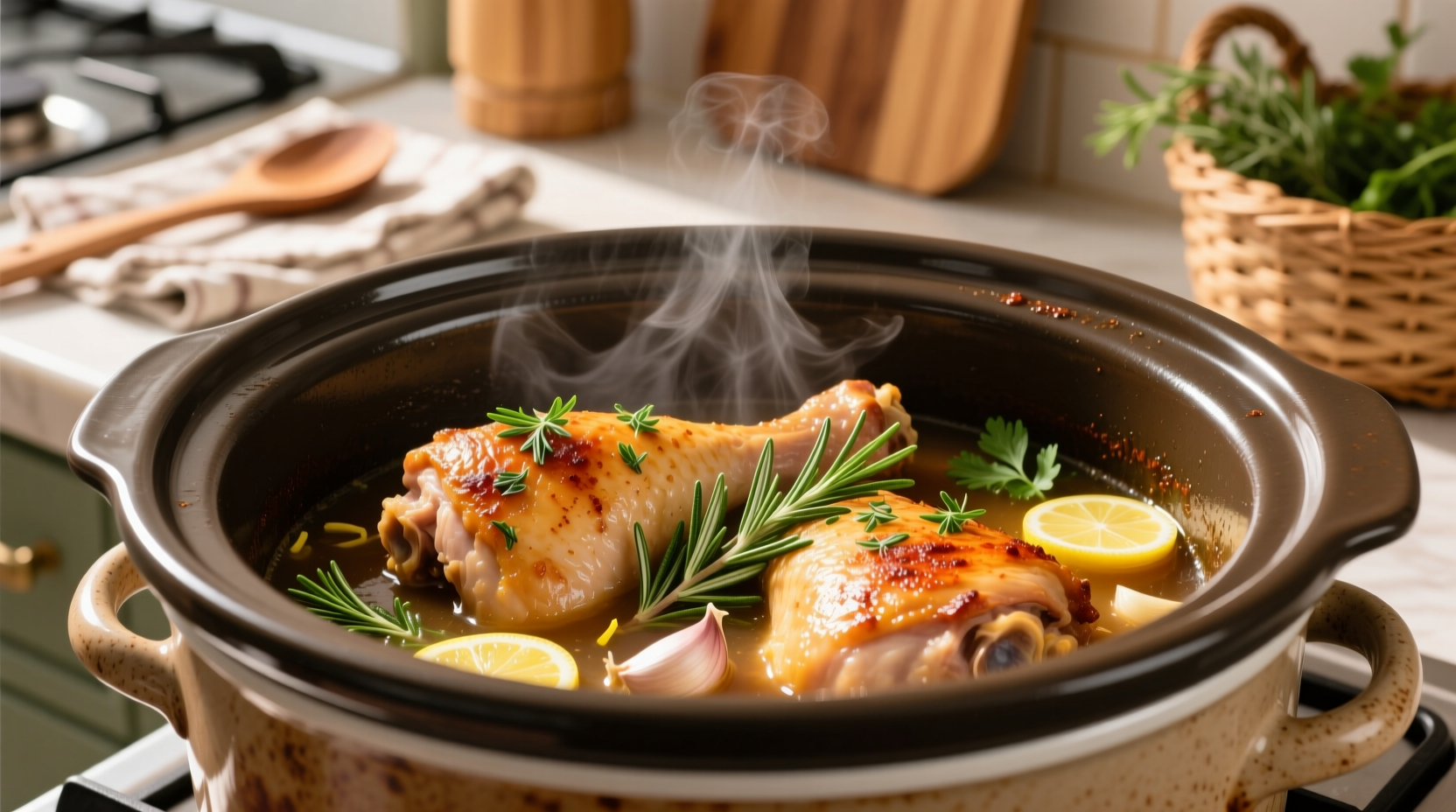Why Cooking Time Varies for Chicken Thighs
Getting perfectly tender chicken thighs in your slow cooker depends on several factors beyond just timing. Understanding these variables ensures consistent results every time you cook:
Temperature Settings Matter Most
Slow cookers operate at different temperatures depending on the setting:
| Slow Cooker Setting | Typical Temperature Range | Recommended Time for Chicken Thighs |
|---|---|---|
| LOW | 190-200°F (88-93°C) | 4-5 hours (bone-in), 3.5-4.5 hours (boneless) |
| HIGH | 280-300°F (138-149°C) | 2.5-3.5 hours (bone-in), 2-3 hours (boneless) |
According to the USDA Food Safety and Inspection Service, poultry must reach 165°F (74°C) to be safe for consumption. Slow cookers work by maintaining a consistent temperature that gradually breaks down connective tissues while ensuring food safety.
Step-by-Step Slow Cooker Chicken Thighs
Follow these professional techniques for fail-proof results:
Preparation Essentials
- Dry the skin with paper towels before seasoning (critical for better browning)
- Season generously under and over the skin with salt, pepper, and your preferred spices
- Arrange in a single layer with thicker parts toward the outside of the pot
Cooking Process
- Place chicken thighs in slow cooker with any aromatics (onions, garlic, herbs)
- Add 1/4 cup liquid (broth, wine, or water) to create steam and prevent scorching
- Cook on LOW for 4-5 hours or HIGH for 2.5-3.5 hours for bone-in thighs
- Check internal temperature at the thickest part, avoiding bone contact
- Rest 10-15 minutes before serving for juicier results
Food Safety and Quality Considerations
University of Minnesota Extension research shows that collagen in chicken thighs begins breaking down at 160°F (71°C), but requires sustained heat to achieve that signature fall-off-the-bone texture. This explains why cooking beyond the minimum safe temperature often yields better texture:
- 165°F (74°C): Safe to eat, but may still be slightly firm
- 175-185°F (79-85°C): Optimal for tender texture while maintaining moisture
- 190°F+ (88°C+): Risk of drying out, especially for boneless thighs

Troubleshooting Common Issues
Undercooked Chicken
If your chicken hasn't reached 165°F after the recommended time:
- Check if your slow cooker is functioning properly (older models may run cooler)
- Ensure you're not overfilling the pot (should be 1/2 to 2/3 full)
- Verify you're using an accurate instant-read thermometer
Dry or Tough Texture
Causes and solutions:
- Overcooking: Boneless thighs become dry faster than bone-in - reduce time by 30-60 minutes
- Incorrect temperature: HIGH setting can cause outer portions to overcook before center reaches safe temperature
- Lack of fat: Chicken thighs have more fat than breasts, but trimming excess can lead to dryness
Flavor Variations and Cooking Tips
Professional chefs use these techniques to maximize flavor development in slow-cooked chicken:
- Pre-sear for depth: Brown thighs in a skillet before transferring to slow cooker (adds Maillard reaction complexity)
- Acid balance: Add citrus juice or vinegar in the last 30 minutes to brighten flavors
- Fat management: Skim excess fat after cooking for cleaner flavor profile
- Finishing touch: Broil for 2-3 minutes after cooking for crispy skin
Storage and Reheating Guidelines
Properly stored slow-cooked chicken thighs maintain quality for:
- Refrigeration: 3-4 days in airtight container
- Freezing: 2-3 months with minimal quality loss
Reheat gently in sauce or broth to maintain moisture. Microwave reheating often dries out the meat - if necessary, cover with damp paper towel and heat in 30-second intervals.
Frequently Asked Questions
Can I cook frozen chicken thighs in a slow cooker?
Yes, but increase cooking time by 50% and ensure thighs reach 165°F internally. The USDA recommends against cooking frozen meat in slow cookers due to potential time spent in the danger zone (40°F-140°F), but if necessary, use HIGH setting and check temperature after 3 hours.
Why are my chicken thighs still tough after 5 hours?
Toughness usually indicates either undercooking or insufficient time at proper temperature. Chicken thighs need sustained heat to break down collagen. Verify with a thermometer - they may need additional time until reaching 175-185°F for optimal tenderness while remaining safe.
Should I flip chicken thighs during slow cooking?
Flipping isn't necessary in a slow cooker. The gentle, moist heat circulates evenly. However, if cooking without liquid (like for crispy skin recipes), flipping halfway through can promote even browning. For traditional braises, leave undisturbed for best results.
How do I know when chicken thighs are done without a thermometer?
While a thermometer is essential for food safety, visual cues include: juices running clear (not pink), meat easily pulling away from bone, and fork-tender texture. However, these methods are less reliable than temperature checking, especially for beginners.
Can I overcook chicken thighs in a slow cooker?
Yes, despite their higher fat content, chicken thighs can become dry and stringy if cooked too long. Bone-in thighs tolerate longer cooking (up to 6 hours on LOW), but boneless typically become dry after 5 hours. For best texture, check after minimum recommended time and remove once tender.











 浙公网安备
33010002000092号
浙公网安备
33010002000092号 浙B2-20120091-4
浙B2-20120091-4